Content
Astrantia (zvezdovka) is an irreplaceable perennial in landscape design. The plant became famous for its beautiful flowers of white, pink or purple color, reminiscent of pointed stars. They do not leave the bushes all summer, attract pollinating insects and are great for cutting. Planting and caring for Astrantia in the open field does not require much effort. This is another plus in the treasury of the virtues of culture.
Astrantia breeding methods
Astrantia can be propagated on the site in two ways: by dividing the bush and by seeds. The first method is applicable only to plants over 5 years old. It is preferable for valuable crop varieties - their unique characteristics are fully preserved. Thanks to this event, the mother bush rejuvenates and becomes more decorative.
It is not necessary to wait for years to get the desired "shares" of Astrania, because they can be purchased from trusted suppliers. If the planting material was purchased in winter or early spring, it can be grown up before planting in open ground. In addition to a full-fledged "delenka", rosettes with root rudiments can be separated from the bush. First, they are deposited in a mixture of peat and humus, and then settled in a permanent place.
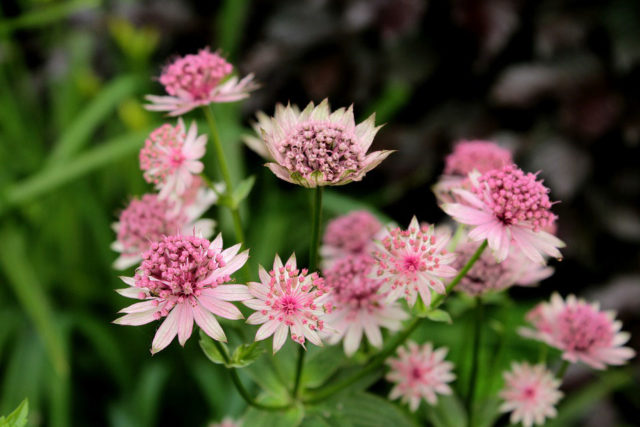
With seed propagation of Astrantia, some of the unique characteristics of the variety are lost.
Astrantia is distinguished by a high percentage of seed germination. After planting, a large number of new specimens are obtained for decorating the garden. The sprouts that appear adapt well to the surrounding conditions, but they lose some of the features of the mother plant.
Seed propagation of Astrantia is carried out in two ways:
- direct planting in open ground;
- sowing in a shelter for seedlings.
When to plant astrantia
Planting seedlings obtained by dividing the bush, gardeners are engaged in early spring or late autumn. It is important that the plant at this moment is not in a state of active vegetation. The time to plant seeds depends on the approach used:
- For seedlings in early spring... Seeds are planted in boxes in March. So, by the end of May, the seedlings of Astrantia will be ready for transplantation to a permanent place.
- In the open ground in the springth. A period is suitable for planting when the earth warms up to a depth of 15 cm. Seeds by this time must undergo artificial stratification.
- In the open ground in autumn... The seeds are lowered into the ground after the first frost. Thus, the planting of Astrantia in the Moscow region and other regions of the middle lane is planned for November, and leaving will begin after the appearance of spring shoots. This is how the seed undergoes natural stratification.
How to grow astrantia from seeds
Planting and further care of Astrantia in the open field is successfully carried out even by beginners, as evidenced by numerous photos of graceful buds. It has no special requirements for the location and composition of the soil. The plant can do without feeding and watering for a long time. However, more attention should be paid to seeds and young shoots.
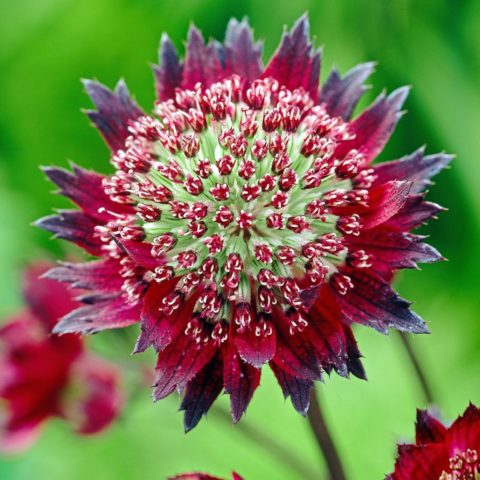
Thanks to the work of breeders, a lot of garden forms of astrania have appeared.
Seed and soil preparation
When planting astrantia in a permanent place before winter, the seeds do not need to be specially prepared. The breeding material collected in the same year is sown on slightly frozen soil and sprinkled with a thin layer of earth. There is no need to water the area after planting. Winter cooling (stratification) will contribute to the amicable emergence of seedlings in early spring.
If the gardener decides to keep the seeds until spring, artificial stratification is a prerequisite. To do this, they are mixed with wet sand and poured into a jar. The container is placed in the vegetable section of the refrigerator for the entire period until planting. It is important to ensure that the sand with seeds does not dry out.
In order for Astrantia to show maximum decorativeness, the soil should be enriched with organic fertilizers before planting. A small amount of river sand in the soil will help the roots develop faster. For seedlings, both a substrate for flowers or vegetable crops, and garden soil enriched with organic matter are suitable.
Planting astrantia seeds
In autumn or spring, Astrantia is planted in open ground in this way:
- dig up the soil by 15-20 cm;
- make grooves 1.5 cm deep;
- sow seeds;
- sprinkle them with a thin layer of earth;
- mulch with peat.
Planting seedlings consists of the following steps:
- pick up a box with drainage holes;
- fill it with a light nutritious substrate;
- sow seeds on a flat surface;
- sprinkle them with a thin layer of earth;
- moisten from a spray bottle;
- cover with a transparent film or glass (the temperature should not exceed 20-23 ° C).
Seedling care
When growing seedlings of Astrantia from seeds at home, it is important to adhere to some rules. Immediately after the appearance of the seedlings, the shelter is removed. The box is placed in the brightest place. If the sun is not enough, it is necessary to provide additional lighting for young sprouts. Astrantia seedlings must be protected from drafts.
Seedling care activities:
- Polyc - carried out after the soil surface has dried.
- Looseninge - follows the moistening of the soil.
- Thinning - produced in 7-10 days after the appearance of seedlings.
- Picking - at the two-leaf stage, the plants are planted in separate pots.
- Hardening - 10-14 days before disembarking to a permanent place.
Thinning is carried out in such a way that a distance of 2-3 cm remains between adjacent shoots. Hardening is a step-by-step process. First, the container with young sprouts is kept in the fresh air for 2-3 hours. The duration of hardening is slightly increased every day. Before transplanting, the seedlings should be ready to spend on the street around the clock.
When and how to plant outdoors
Planting hardened seedlings in a permanent place is carried out in the last days of spring or early summer. Both sunny and slightly shaded areas work well. Astrantia has no special requirements for the soil, but it is better to enrich it with organic matter to increase its nutritional value and friability.
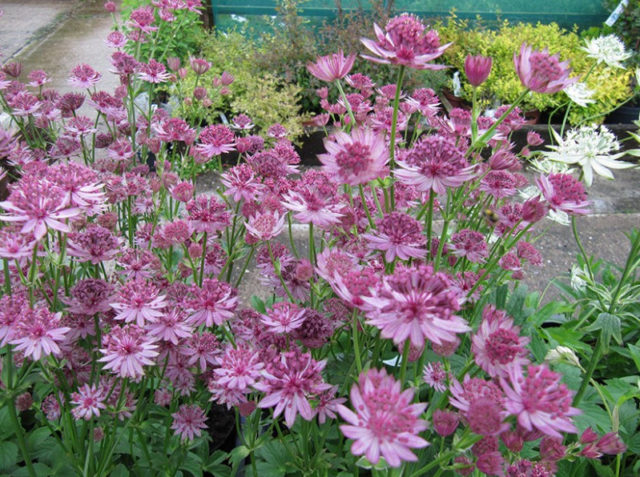
The plant is resistant to cold and drought
First of all, the soil in the selected area is carefully loosened. For planting young shoots, holes are dug at intervals of 30-40 cm. They are immersed underground to the same level as before. At the end, the soil is thoroughly tamped and watered abundantly.
Follow-up care
Astrantia tolerates mild drought well. If the hot season is delayed, it is necessary to provide her with weekly watering. In order for the first wave of flowering to be replaced by the second, the surrounding soil should not be allowed to dry out. After planting astrantia, one should not forget about removing weeds and loosening. A mulching layer of humus or peat will prevent moisture evaporation and the growth of weeds.
To make astrantia in the garden look as attractive as in the photo, it needs feeding every spring. Complex mineral fertilizer is applied in March under each bush. The second time the crop can be fed in July or August using potash-phosphorus fertilizer.To prevent self-seeding and stimulate the formation of new flowers, withering buds should be cut off. Over time, the long stems of Astrantia can bend to the ground. In this case, you need a reliable support. After 5 years, the bush is rejuvenated through root division with a transplant.
Diseases and pests
Astrantia has a high immunity against all kinds of diseases. The defeat occurs only with extremely improper care. The most common case: the development of a fungus as a result of excess moisture. If it's not about excessive watering, but about natural precipitation, you need to loosen the soil as often as possible, reduce its acidity and make it lighter. Reliable fungicides help in the fight against fungus.
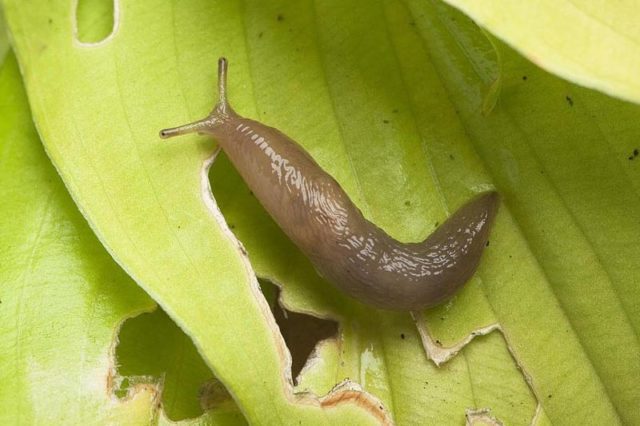
Naked slug is the main pest of Astrania
Even with proper care of the long-term Astrania after planting, one can encounter the spread of naked slugs depicted in the photo. They mercilessly eat the leaves of the culture. In the fight against them, several methods are used:
- pour dry earth;
- arrange bait in the form of glasses of beer;
- collect pests by hand.
When and how to collect seeds
Collecting seeds for planting is carried out according to the following plan:
- Leave some of the largest and most beautiful buds without cutting.
- Wrap them with gauze to prevent seeds from scattering.
- Cut the flowers after drying completely.
- Lay them out on a newspaper in a dry room for additional drying.
- Release the seeds and cleanse them of petals.
- Place them in a tissue bag or paper box.
- Placed for storage in a dry and dark place.
Preparing for winter
The root system of Astrantia tolerates frost well. In the fall, it is necessary to make large pruning, making cuts with a sharp pruner at ground level. After that, the bushes are covered with a layer of peat or humus.
If the planting was carried out this year, it is better to additionally protect the immature bushes for the winter with spruce branches or leaves. An adult plant does not need additional insulation. However, if the region experiences very freezing winters, it won't hurt.
Astrantia in landscape design
Landscape designers often practice planting astrania in a separate flower bed on the lawn. It looks good among trees and against the background of bushes. It is used in the creation of borders and ridges, as well as compositions in a natural style. Thanks to its small roots, it can be planted in a rock garden. Different varieties of astrantia are successfully combined with each other, although monoplanting also looks attractive.
The culture looks most impressive in mixborders. Here she often coexists with lungwort, astilba, acroclinum, ayuga, geranium, heuchera, mordovik, bell, gailardia, buzulnik, dahlias, daylily, phlox, begonias, hosts and cereals. A vivid example of a successful combination of Astrantia with other flowers in a flower bed is shown in the photo.
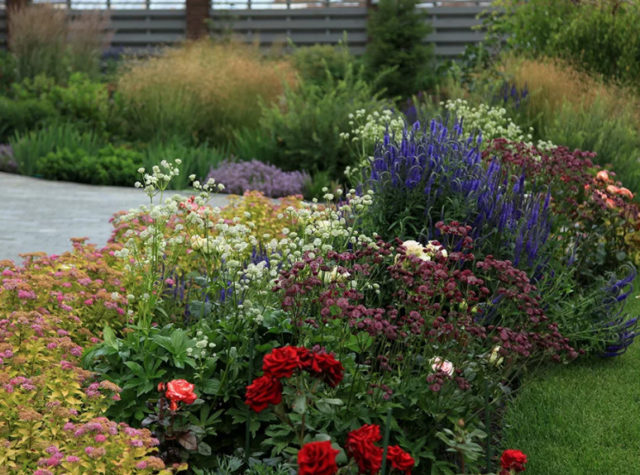
Most often, astrania is used to create mixborders.
One of the popular ideas for landscape design is to place astrantia in the center of the decorative composition near the entrance to the room. It looks especially effective when surrounded by rejuvenated, stonecrop or loosestrife. Various flowering and leafy crops are used as additional elements.
Conclusion
Planting and caring for Astrania outdoors does not require much effort. The plant grows well in the sun and shady areas, on fertile and poor soils. Its star-shaped flowers perfectly complement various compositions on the site throughout the summer, and also become components of live or dry bouquets.








